How Do You Find the Right Packaging Equipment for Your Food Product?
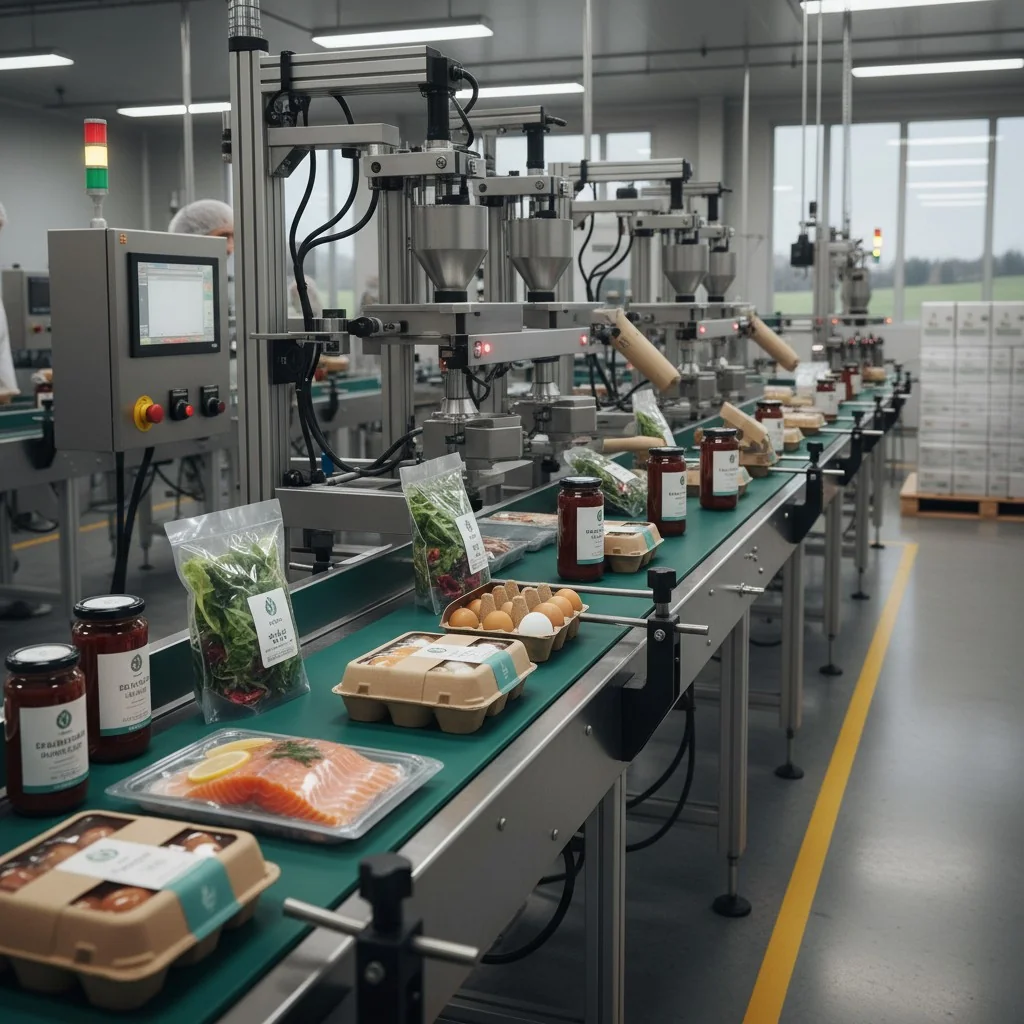
Your food product is perfect, but the wrong packaging can ruin it. This leads to spoilage, lost money, and a damaged brand reputation, undoing all your hard work.
To find the right packaging, you must match the equipment to your food's specific needs. Consider factors like shelf life, protection, and presentation. Key technologies include vacuum sealing, Modified Atmosphere Packaging (MAP), and thermoforming, each ideal for different food categories.
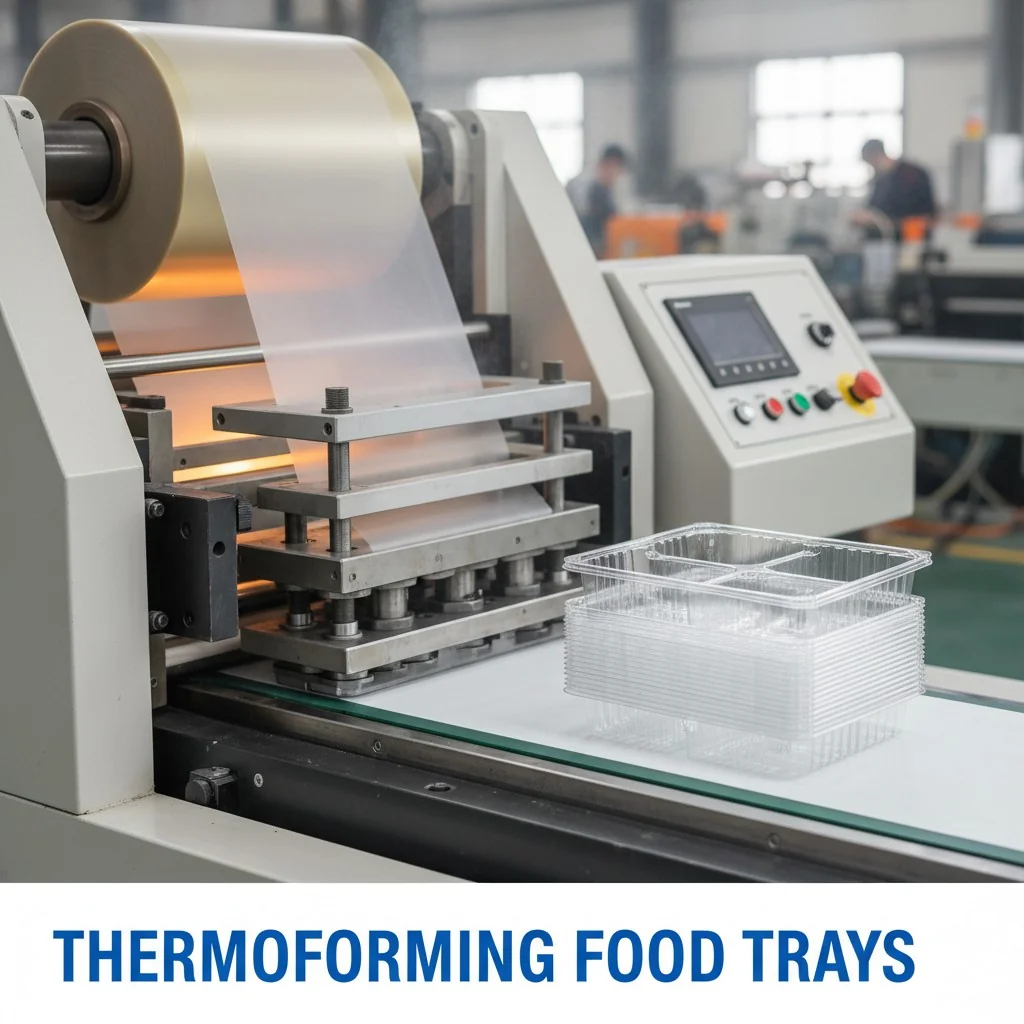
Choosing the right manufacturing partner is one of the most important decisions you'll make. I learned this lesson early in my career. I was helping a client who was launching a new line of artisanal cheeses. Their first packaging choice was a disaster. The seals were weak, and they lost their entire first batch to spoilage. It was a painful but valuable lesson: the package is just as critical as the product inside. We had to go back to the drawing board, focusing on the mold design for a new thermoformed container and the material science behind it. This experience taught me the value of a supplier who understands the whole process. That's why I often point people to partners like Xiamen Xiaosen Packaging. They don't just sell you a machine; they understand the materials, the design, and how to protect the food. Finding a partner with that deep knowledge is the key to getting it right.
Thermoforming molds are typically made from aluminum because it offers good thermal conductivity and is easy to machine.True
Aluminum is a common choice for thermoforming molds, especially for prototypes and medium production runs, due to its excellent heat transfer properties and lower cost compared to steel.
All food-grade plastics are safe for both hot and cold foods.False
Not all food-grade plastics are stable at high temperatures. For example, PET is great for cold items but can warp or leach chemicals if heated, whereas CPET is designed for oven and microwave use.
What's the Best Packaging for Meat & Plant-based Protein?
Your fresh meat or plant-based protein looks great, but it spoils quickly. Poor packaging leads to discoloration and waste, costing you money and turning away customers who demand freshness.
For meat and plant-based proteins, the best solutions are Vacuum Skin Packaging (VSP) and Modified Atmosphere Packaging (MAP). These technologies extend shelf life by removing or controlling oxygen, which prevents spoilage and keeps the product looking fresh and appealing on the shelf.
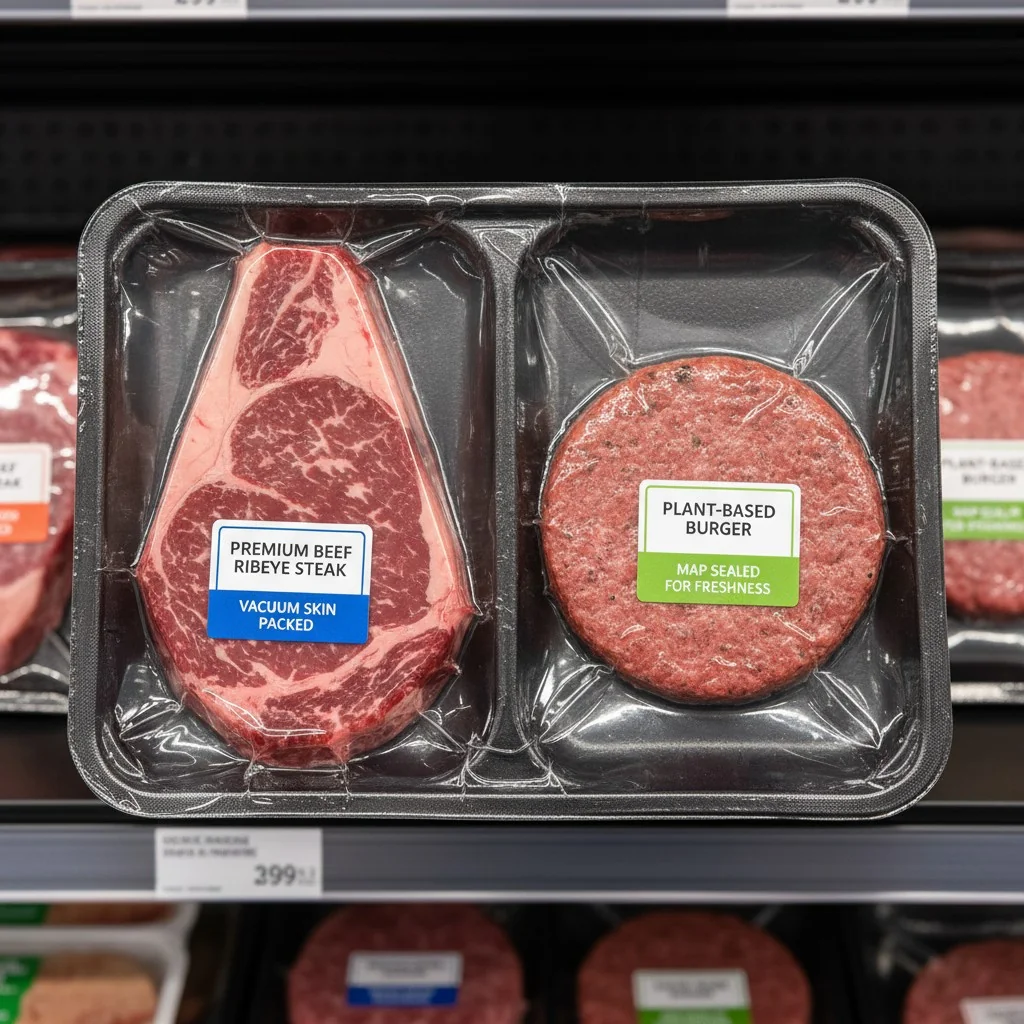
When we talk about packaging meat, we are really fighting against time and biology. Two main things cause meat to go bad: microbial growth and oxidation. Oxidation is what turns red meat that unappealing brown color. To solve this, we need to control the atmosphere inside the package. This is where the design of the packaging, and the molds that create it, becomes so important.
Key Packaging Technologies
The technology you choose directly impacts your product's shelf life and appearance.
| Technology | How It Works | Best For |
|---|---|---|
| Vacuum Skin Packaging (VSP) | A top film heats and drapes over the product, sealing to the bottom tray like a second skin. All air is removed. | Premium cuts, showcasing texture, and extending shelf life. |
| Modified Atmosphere Packaging (MAP) | The air in the package is replaced with a specific gas mixture (often CO2, N2) to slow spoilage. | Ground meat, sausages, and plant-based patties. |
| Simple Overwrap | A plastic film is stretched over a tray. This offers minimal protection and very short shelf life. | In-store butcher counters for immediate sale. |
The trays used in VSP and MAP are often made through thermoforming. The mold design for these trays is critical. It must ensure uniform wall thickness for strength and a perfect sealing surface to maintain the package's integrity.
Vacuum Skin Packaging can triple the shelf life of fresh meat compared to simple overwrap.True
By removing nearly all oxygen, VSP significantly slows the growth of aerobic bacteria and prevents oxidation, extending shelf life from a few days to several weeks.
Plant-based meats require the exact same packaging gas mixture as red meat.False
While the principles are similar, plant-based products often have different spoilage mechanisms and may require a unique gas blend in MAP to maintain their texture and flavor profile.
How Should You Package Poultry?
Poultry is highly susceptible to bacteria like Salmonella. If your packaging fails, you risk not just spoilage but serious health concerns and a recall that could destroy your brand's reputation.
The most effective packaging for poultry combines absorbent pads with either MAP or VSP. The pad manages excess moisture, called purge, while the controlled atmosphere teknolojisi inhibits bacterial growth, ensuring safety and extending freshness.
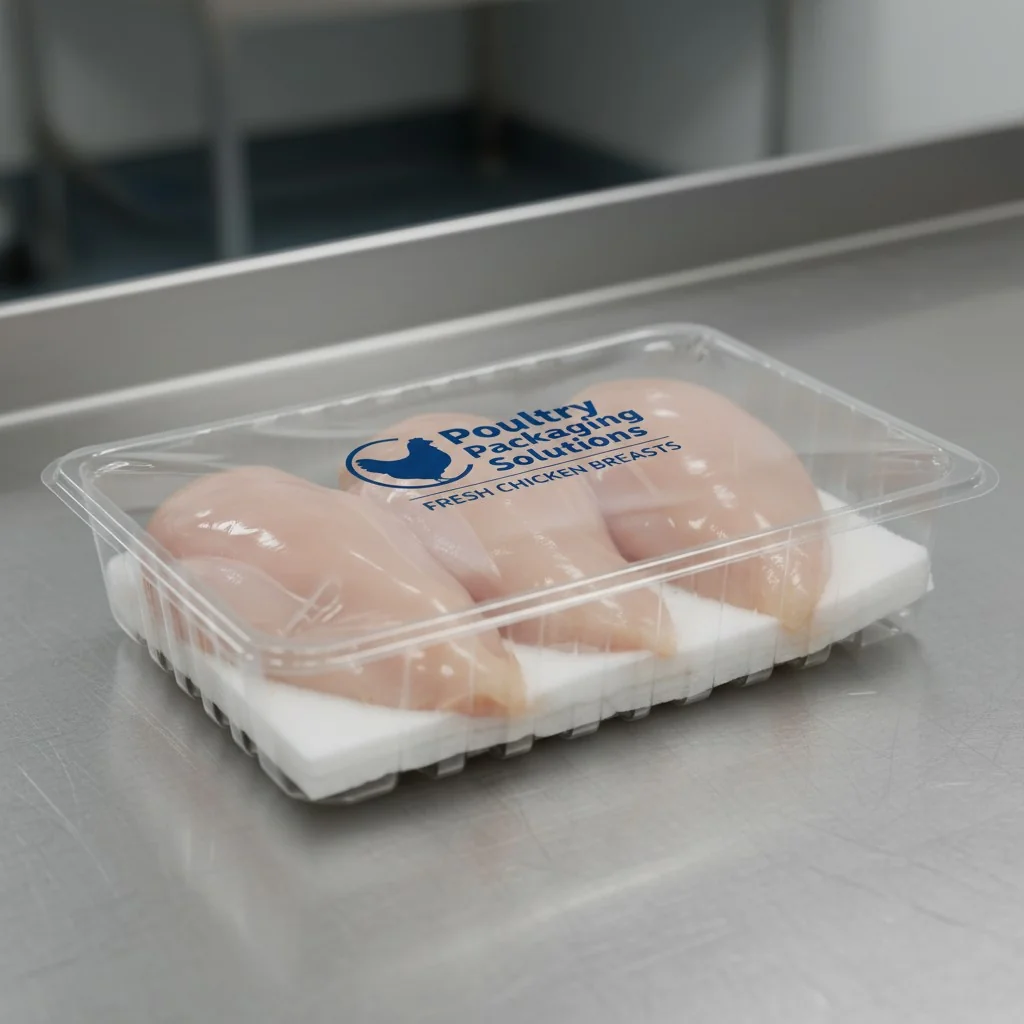
Packaging poultry presents a unique challenge: managing moisture. Chicken naturally releases liquid, known as "purge." This liquid is a breeding ground for bacteria. So, your packaging solution has to do two jobs at once: control the atmosphere and handle this excess moisture. This is why you almost always see an absorbent pad at the bottom of a poultry tray.
Designing for Safety and Freshness
A good poultry package is a complete system. It's not just a tray and a lid.
- Absorbent Pads: These are crucial. They soak up the purge, keeping the surface of the chicken drier and slowing bacterial growth. The pad itself must be made of food-safe, non-toxic materials.
- Tray and Film Selection: The tray, often thermoformed PP (Polypropylene), needs to be rigid enough to protect the product. The sealing film must create an airtight barrier to maintain the modified atmosphere. The mold used to create the tray must be designed to accommodate the pad and ensure a flat, even sealing flange.
- Gas Mixture in MAP: For poultry, a common MAP gas mixture is high in carbon dioxide (CO2) and low in oxygen (O2). The CO2 inhibits the growth of common spoilage bacteria, directly extending the product's safe-to-eat window.
This multi-component approach is the industry standard for a reason. It provides the safety and shelf life that both retailers and consumers expect.
The color of an absorbent pad indicates the freshness of the poultry.False
The pad's color saturation only indicates the amount of liquid (purge) the poultry has released, not necessarily its freshness. Freshness is better determined by the 'use-by' date, smell, and texture.
Polypropylene (PP) is often used for poultry trays because it has a high melting point and is resistant to fats and chemicals.True
PP is a durable and safe choice for packaging poultry. Its resistance to fats and its stability at different temperatures make it ideal for containing the product安全ly from the plant to the consumer's kitchen.
What Is the Ideal Packaging for Fish & Seafood?
Fish and seafood are delicate and spoil very quickly, producing strong odors. The wrong packaging can trap these odors and fail to prevent rapid decay, leading to an unpleasant customer experience.
Vacuum Skin Packaging (VSP) is often the ideal choice for fish and seafood. It locks in freshness, prevents freezer burn, and beautifully displays the product's natural texture and color without crushing the delicate flesh.

When I work with clients on packaging, I always say you have to respect the product. And nothing demands more respect than fresh fish. It's fragile, it's sensitive, and it can go from premium to garbage in a day. The main enemies are oxygen and bacteria, which cause the fishy smell and breakdown of the flesh. Your packaging has to be a fortress against them.
Comparing Seafood Packaging Options
Different seafood products have different needs. A sturdy salmon fillet can be packaged differently than delicate scallops.
| Packaging Method | Key Benefit | Best Suited For |
|---|---|---|
| Vacuum Skin Packaging (VSP) | Excellent presentation, long shelf life, prevents freezer burn. | Fresh or frozen fillets (salmon, tuna), shrimp, scallops. |
| Modified Atmosphere Packaging (MAP) | Extends shelf life without compressing the product. | Delicate whitefish, pre-made seafood salads. |
| Frozen & Vacuum Sealed | Maximum shelf life for long-term storage. | Bulk fish, shrimp, and other items for the freezer aisle. |
For VSP, the mold that forms the tray is important. It needs to be shaped to hold the fillet securely. The top film then forms a tight seal, locking out air completely. This process is amazing for freezing. Because there is no air, ice crystals can't form, so you avoid the dreaded freezer burn that ruins texture and flavor. It's a perfect example of how smart engineering solves a very specific product problem.
You can cook fish directly in any VSP packaging.False
While some modern packaging films are designed for 'cook-in' applications (like sous-vide), not all VSP films are heat-stable. You must check the package instructions to see if it is rated as oven-safe or microwave-safe.
The 'fishy' smell of old seafood is caused by the production of trimethylamine (TMA) as bacteria break down fish tissue.True
Fresh fish has very little odor. The strong, unpleasant smell is a direct result of bacterial spoilage, making it a key indicator of a product that is no longer fresh.
How Do You Keep Cheese & Dairy Products Fresh?
Cheese and dairy products are alive with cultures or are sensitive to air. Improper packaging can cause cheese to dry out, yogurt to spoil, or butter to absorb off-flavors from the fridge.
The right packaging for cheese and dairy depends on the product. Hard cheeses need to breathe, so special permeable papers are used. Soft products like yogurt and butter require airtight, injection-molded or thermoformed containers to prevent contamination and oxidation.
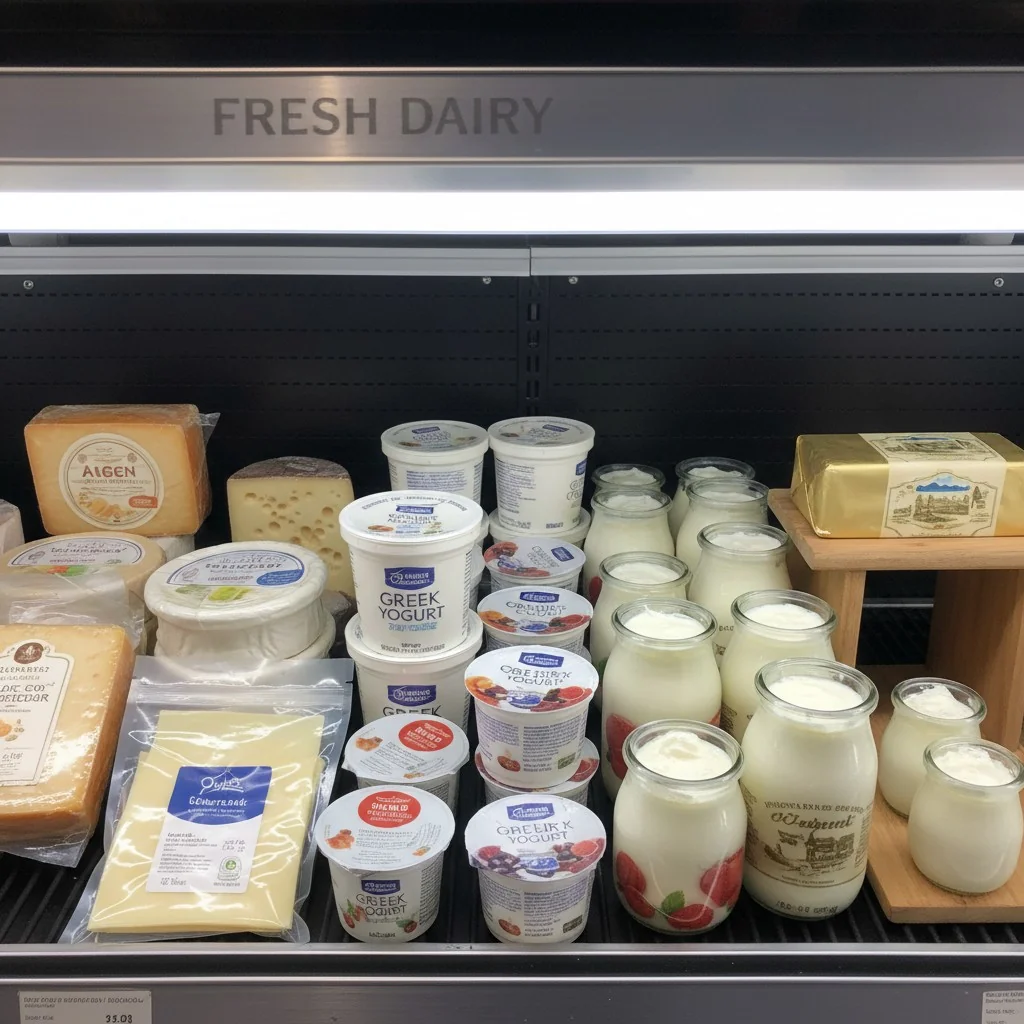
I find cheese packaging fascinating because it's not always about sealing it off from the world. An aged cheddar is very different from a cup of yogurt. I once visited a cheese maker in Europe, and he explained that hard cheese is a living thing. It needs to release gases like ammonia, but you can't let it dry out. This is a classic engineering problem: how do you let something out while keeping something else in?
A Tale of Two Needs: Breathing vs. Sealing
The solution depends entirely on the type of dairy product.
- Hard & Aged Cheeses (e.g., Parmesan, Aged Gouda): These products benefit from special two-ply cheese paper or micro-perforated films. The inner layer wicks moisture to prevent sogginess, while the outer layer allows the cheese to release gas without drying out.
- Soft Cheeses, Yogurt, Butter (e.g., Brie, Greek Yogurt): These need a strong barrier. They are vulnerable to air, light, and outside bacteria. This is where we see rigid containers.
- Thermoformed Cups: Often made from PS (Polystyrene) or PP (Polypropylene), used for yogurt.
- Injection Molded Tubs: Used for products like cream cheese or butter, offering great strength and precise dimensions for a perfect lid fit.
The molds for these tubs and cups are complex. For a yogurt cup, the mold has to create a container that is strong enough to be filled and sealed at high speed, but also thin enough to be cost-effective. It's a balancing act.
Wrapping cheese in standard plastic cling wrap is the best way to store it.False
Standard plastic wrap suffocates cheese. It traps moisture and ammonia, which can ruin the flavor and texture and even encourage the growth of new, unwanted molds.
Light can cause milk and other dairy products to lose vitamins and develop off-flavors.True
This process is called photodegradation. Opaque packaging, like cardboard cartons or colored plastic jugs, is used to protect dairy products from light, preserving their nutritional value and taste.
What's the Secret to Packaging Fresh Produce?
Fresh fruits and vegetables are still alive and breathing. Sealing them in the wrong package can make them suffocate and rot faster, while too much air exposure causes them to wilt and dry out.
The secret is controlling respiration. Produce packaging uses micro-perforated or permeable films that create a balanced Modified Atmosphere. This allows the produce to breathe at a slower rate, extending its crispness and freshness.
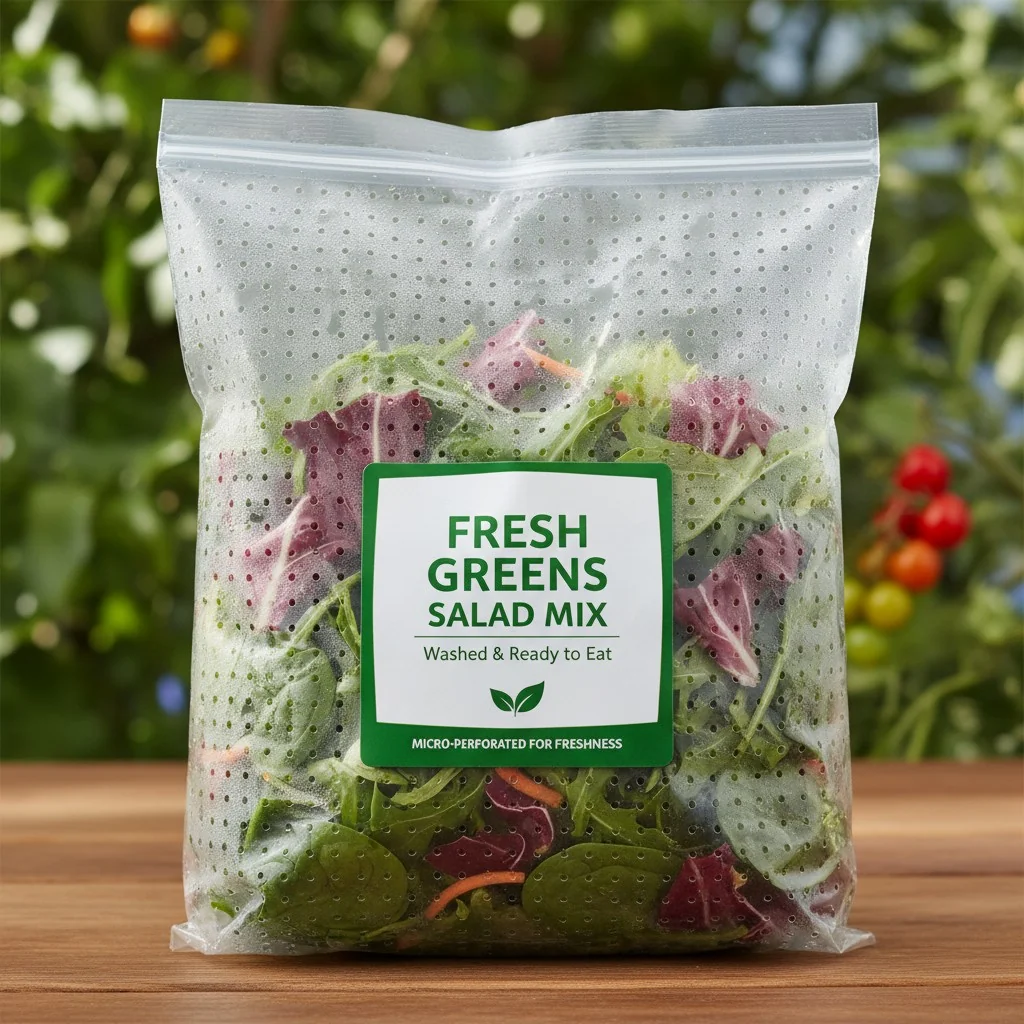
It's easy to forget that a head of lettuce or a bag of apples is still a living organism. After being harvested, they continue to "breathe" — taking in oxygen (O2) and releasing carbon dioxide (CO2), water, and ethylene gas. The speed of this process, the respiration rate, determines how fast it spoils. The goal of produce packaging is to slow down this breathing without stopping it completely.
Engineering the Perfect "Breathing" Room
You can't just use any plastic bag. The packaging is engineered to match the product.
- Respiration Rate: Different produce breathes at different rates. A bag of spinach has a very high respiration rate, while a potato has a very low one. The packaging film must be chosen to match.
- Micro-Perforations: Many produce bags have tiny, often laser-cut, holes. These holes are precisely sized and numbered to create a specific O2 and CO2 balance inside the bag. This is called Equilibrium Modified Atmosphere Packaging (EMAP).
- Anti-Fog Films: As produce respires, it releases water vapor, which can cause fogging inside the package. Anti-fog films have a special coating that causes the water to spread out into a thin, transparent sheet instead of forming view-blocking droplets.
The clamshell containers used for berries are another great example. They are thermoformed from PET, a clear and strong plastic. The mold design includes vents to allow for air circulation, preventing moisture buildup that leads to mold.
Washing berries before storing them in a clamshell makes them last longer.False
Washing berries adds moisture, which encourages mold and bacterial growth. It's best to store them unwashed in their original vented container and wash them just before eating.
Ethylene gas, released by fruits like bananas and apples, can cause other produce to ripen and spoil faster.True
Ethylene is a natural plant hormone that triggers ripening. Storing ethylene-producing fruits separately from ethylene-sensitive vegetables (like lettuce and broccoli) can significantly extend the life of the vegetables.
How Can You Protect Bakery & Confectionery Goods?
Bakery and confectionery items face a dual threat. Hard cookies can absorb moisture and become soft, while soft cakes can lose moisture and become stale. The wrong package guarantees a disappointing texture.
The key is moisture management. For dry, crisp items like cookies and crackers, use high-barrier packaging to keep moisture out. For moist items like cakes, use packaging that locks moisture in.
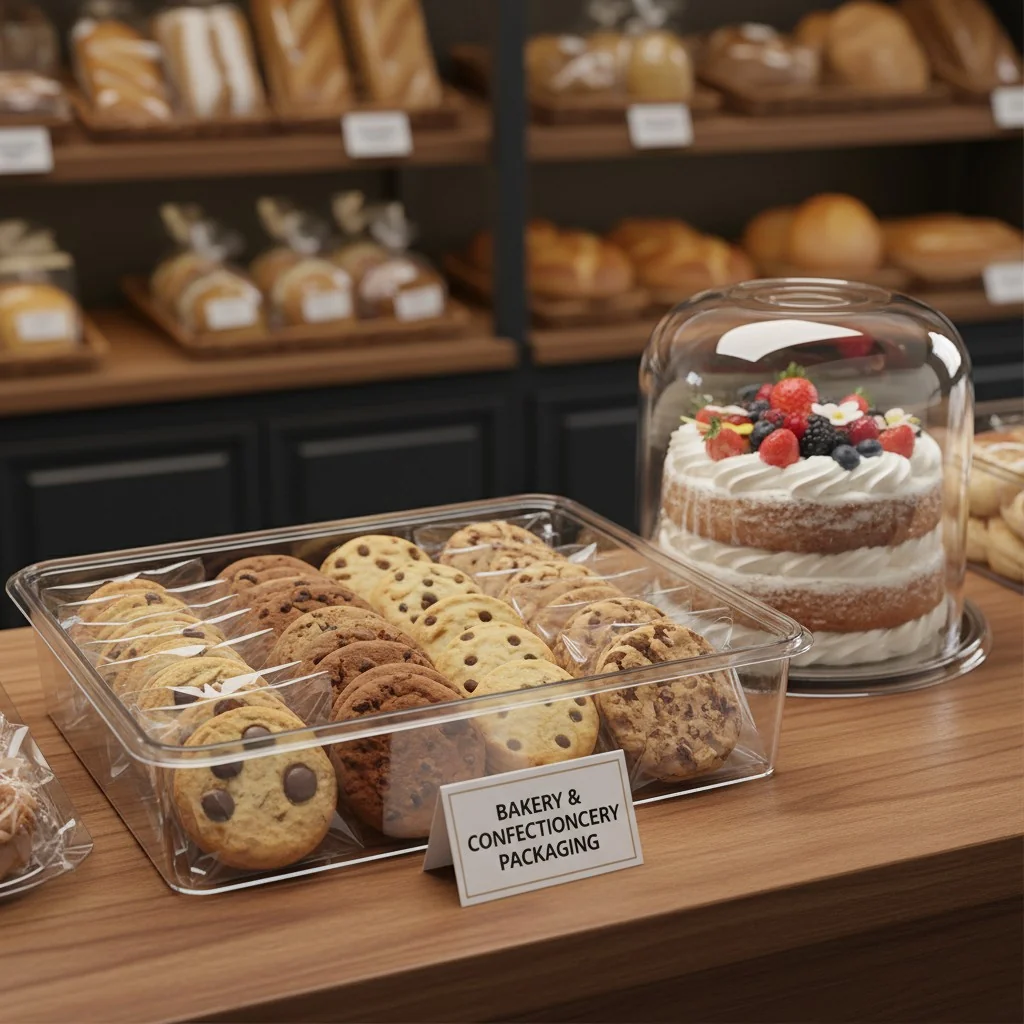
I have a sweet tooth, so I take this category personally. Nothing is worse than a cookie that has lost its snap or a piece of cake that's dry and crumbly. The challenge here is all about water, or the lack of it. The "water activity" of a food product determines whether it will give moisture to the air or take moisture from it. Good packaging controls this exchange.
Choosing the Right Barrier
The type of barrier you need depends on whether you want to keep moisture in or out.
| Product Type | Packaging Goal | Common Packaging Solution |
|---|---|---|
| Crisp/Dry (Cookies, Crackers, Hard Candy) | Keep moisture OUT. | Sealed bags made of metallized or multi-layer films (high moisture barrier). |
| Moist/Soft (Cakes, Brownies, Doughnuts) | Keep moisture IN. | Thermoformed clamshells (PET), windowed paperboard boxes, or flow-wrapped trays. |
| Chocolate | Protect from heat, moisture, and odors. | Foil-wrapped bars, often placed in a secondary paperboard box. |
For products like cookies sold in a tray, the tray itself is often thermoformed from PS or PET. The mold design is critical here. It needs to create pockets that hold the cookies snugly to prevent them from breaking during shipping. The tray is then typically flow-wrapped with a sealing film. For a cake, a clamshell with a high dome, also thermoformed, protects the delicate frosting while locking in the cake's moisture.
Storing chocolate in the refrigerator is the best way to keep it fresh.False
The cold, humid environment of a refrigerator can cause 'sugar bloom,' where moisture dissolves sugar on the surface, leaving a white, grainy coating. It's best to store chocolate in a cool, dry, dark place.
The crinkly sound of a chip bag is intentionally designed to be loud.True
Studies in psychoacoustics have shown that consumers associate a loud crinkle with product freshness and crispness. Manufacturers select film materials, like metallized BOPP, that enhance this sound.
What Makes Good Snack Packaging?
Snacks like chips and nuts go stale and lose their crunch when exposed to oxygen and light. A flimsy bag that doesn't seal properly will lead to stale products and unhappy customers.
Great snack packaging uses high-barrier films, often in a pillow-pouch format, and is flushed with nitrogen. This multi-layer film blocks oxygen, light, and moisture, while the nitrogen cushion protects the fragile product from breaking.
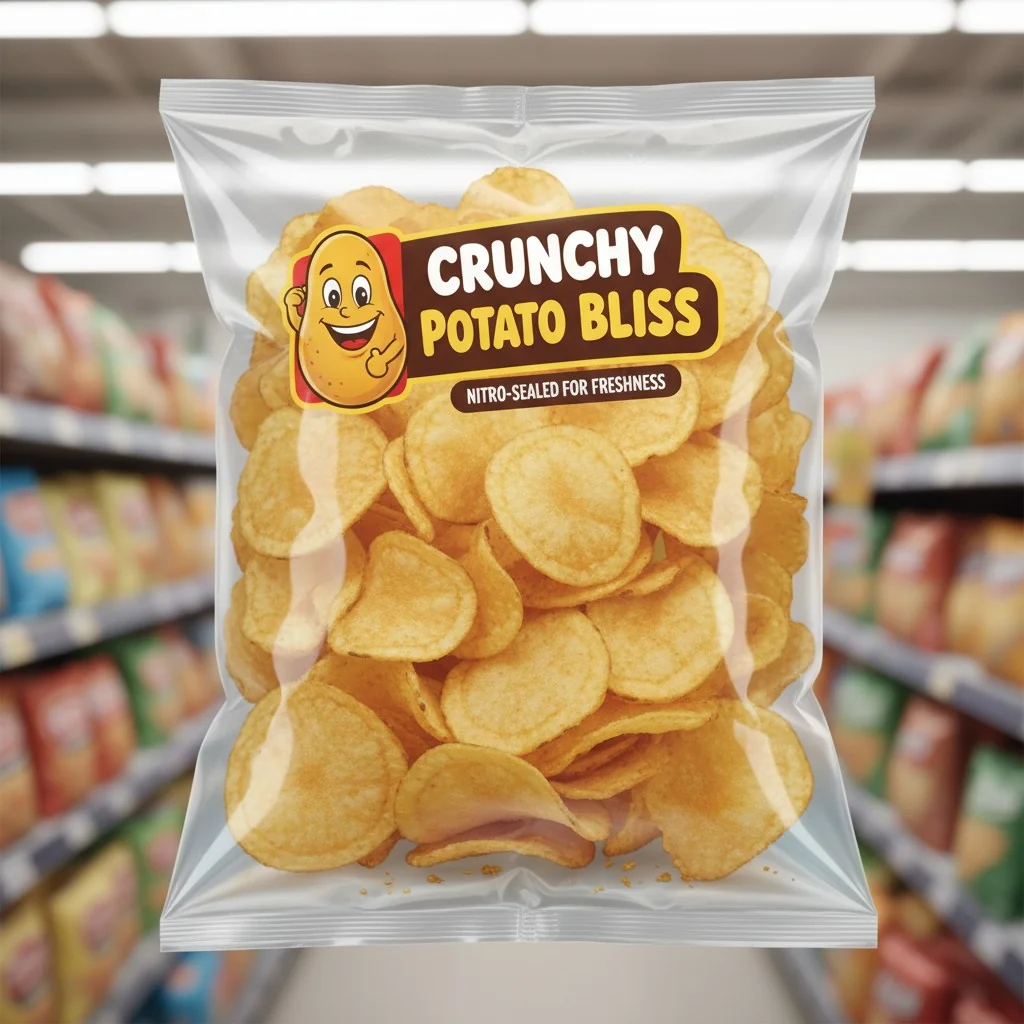
Think about a bag of potato chips. It's a brilliant piece of engineering. It has to do three things perfectly: keep the chips from going stale, keep them from getting crushed, and look great on the shelf. This is much harder than it looks. The main enemies are oxygen, which makes the oils in the chips go rancid, and physical impact, which turns them into crumbs.
The Anatomy of a Chip Bag
That simple bag is actually a high-tech system.
- Multi-Layer Film: Snack bags are not just one layer of plastic. They are typically a laminate of several materials.
- Outer Layer (e.g., BOPP): This is for printing the graphics. It's strong and glossy.
- Middle Layer (e.g., Metallized PET or Foil): This is the most important barrier. It blocks oxygen, moisture, and light.
- Inner Layer (e.g., PE): This is the sealant layer. It's what allows the bag to be heat-sealed securely.
- Nitrogen Flushing: Before the bag is sealed, the air inside is replaced with nitrogen. Nitrogen is an inert gas, meaning it doesn't react with the food. This "gas flush" pushes out the oxygen, preventing staleness. It also inflates the bag, creating a cushion that protects the chips from being crushed. This is a form of Modified Atmosphere Packaging.
The machine that does this is a Vertical Form Fill Seal (VFFS) machine. It forms the bag, fills it with the snack, flushes it with nitrogen, and seals it, all in a continuous, high-speed motion.
The air in a chip bag is just regular air to make it look like there's more product.False
The gas in a chip bag is almost always nitrogen. This is called 'slack fill,' and its primary purpose is to protect the fragile chips from breaking and to prevent the oils from going rancid by displacing oxygen.
Clear snack bags are better because you can see the product.False
While you can see the product, clear bags offer little to no protection from light. Light can accelerate the oxidation of fats, leading to off-flavors and a shorter shelf life, which is why most chip bags are opaque.
How Do You Package Ready Meals?
Ready meals need to go from the store shelf to a microwave or oven. The packaging must be safe for heating, prevent leaks, and perfectly preserve the taste and texture of a complete meal.
The best packaging for ready meals is a heat-resistant, sealable tray, often made from CPET or PP, and sealed with a vented or peelable film. This allows the consumer to heat the meal safely and conveniently in its own container.
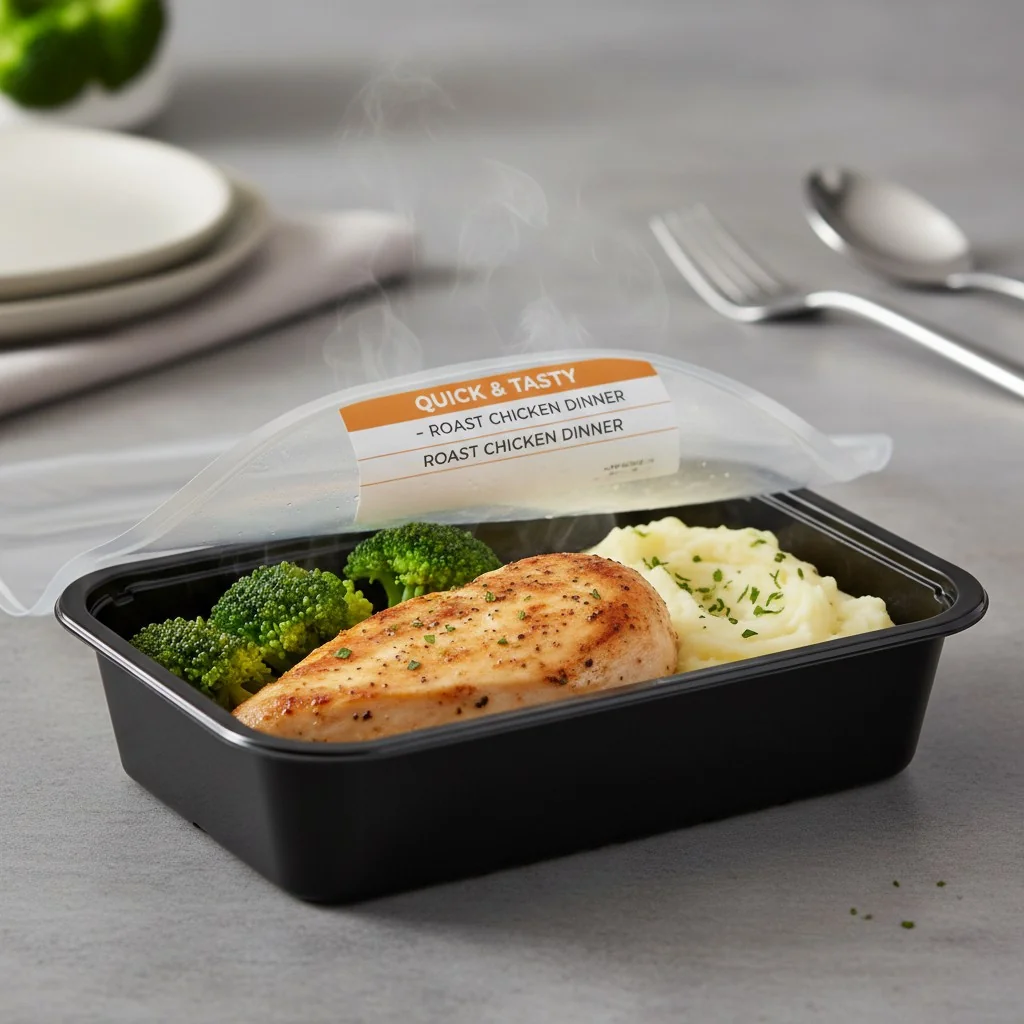
The ready meal market has exploded, and packaging innovation is a huge reason why. The entire value proposition is convenience. This means the packaging has to be part of the cooking process, not an obstacle. I've seen many companies struggle with this. They get the food right, but the tray warps in the microwave, or the film is impossible to peel off.
Designing for the Kitchen
The package must be designed with the end-user's kitchen in mind.
- Material is Everything: The choice of plastic is the most important decision.
- CPET (Crystallized Polyethylene Terephthalate): This is the workhorse for oven-safe meals. It can withstand temperatures from the freezer (-40°C) to a conventional oven (up to 220°C).
- PP (Polypropylene): This is a great, cost-effective choice for microwave-only meals. It's durable and has good heat resistance for microwave temperatures.
- Sealing Film: The film that seals the tray is also highly engineered. It needs to provide a strong seal to prevent leaks, but it also often needs to be "easy-peel" for a good user experience. Some films are designed to self-vent during microwaving, letting steam escape safely without the need to puncture the film first.
The thermoforming molds that create these trays must be incredibly precise to produce a container that can handle extreme temperature changes without warping or cracking.
You can use any plastic container to microwave food.False
This is dangerous. Only plastics labeled as 'microwave-safe' (often PP, designated with a #5) should be used. Other plastics, like PS (#6) or PVC (#3), can warp, melt, or leach harmful chemicals into food when heated.
Black plastic food trays are colored with carbon black, which makes them difficult for recycling facility scanners to identify.True
The carbon black pigment absorbs the near-infrared (NIR) light used by most automated recycling sorters. As a result, black plastic trays are often not sorted correctly and end up in landfills, even if they are made from a recyclable material like PET or PP.
What Are the Requirements for Pet Food Packaging?
Pet food, especially wet food and premium kibble, needs to stay fresh to be palatable and nutritious. Dry kibble can go stale and lose its vitamin content, while wet food requires a sterile, airtight seal.
Dry pet food requires large, high-barrier bags with a resealable feature like a zipper or slider. Wet food demands a complete barrier, achieved with either metal cans or heat-sterilized (retort) plastic trays or pouches.
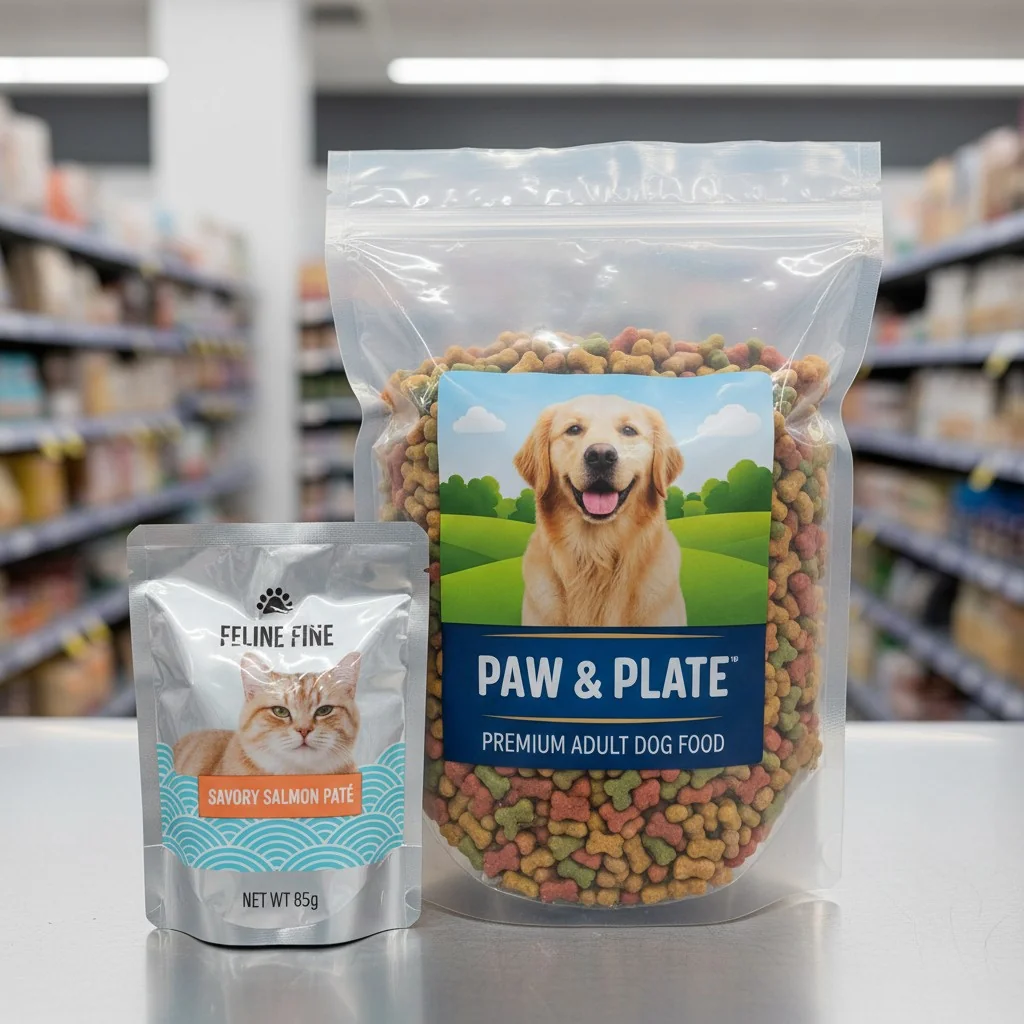
People treat their pets like family, and they are willing to pay for high-quality food. They expect the packaging to protect that quality. I've noticed the pet food aisle looks more and more like the human food aisle, with a focus on fresh ingredients and convenient packaging. The engineering challenges are very similar.
Dry vs. Wet: Two Different Worlds
The packaging needs for dry kibble and wet food are completely different.
| Food Type | Primary Challenge | Packaging Solution |
|---|---|---|
| Dry Kibble | Oxidation of fats, moisture absorption, large volumes. | Large, multi-layer bags (often woven PP or laminated films) with a barrier to block oxygen and moisture. A resealable zipper is a key feature for convenience. |
| Wet Food | Bacterial spoilage, long-term shelf stability. | Cans: The traditional solution, offering a perfect sterile barrier. Retort Pouches/Trays: A modern alternative. The food is sealed in a multi-layer plastic/foil pouch and then heat-sterilized. |
Retort pouches are a great innovation. They are lighter than cans, which saves on shipping costs, and they have a large surface area for branding. The material is a sophisticated laminate, often including layers of PP, aluminum foil, and PET. This combination can withstand the high heat and pressure of the retort sterilization process while remaining a perfect barrier. The molds for retort trays must also be designed to handle this intense process without deforming.
You should store dry pet food in its original bag.True
High-quality pet food bags are designed with a barrier to keep out oxygen and light, which preserves the fats and vitamins in the food. Pouring it into a separate plastic container often exposes it to more air, accelerating staleness.
Retort pouches were originally developed for the military as a replacement for canned rations.True
The technology was developed in the 1950s and 60s by the U.S. Army to create a lighter, more durable, and easier-to-pack field ration, which became the Meal, Ready-to-Eat (MRE).
Conclusion
Choosing the right packaging is not an afterthought; it is essential to your product's success. By understanding your food's needs and the available technologies, you can ensure quality, safety, and customer satisfaction.
